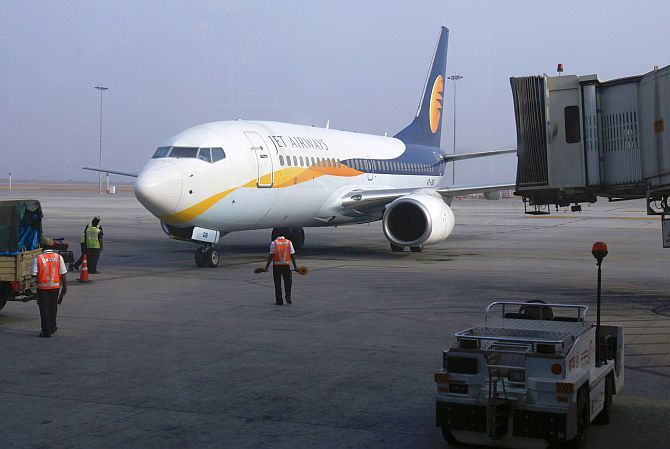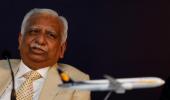An overriding ambition to rule the domestic skies prevented Jet Airways from becoming a strong and formidable player in the international market. The Sahara buy added to the complexity of its operations and a dilution of what the airline stood for, says Anjuli Bhargava.

As the Jet Airways saga appears to be drawing to a close, it may be worthwhile to try and understand what went wrong.
When did things slip so out of control?
This is the question industry, passengers, frequent fliers, businessmen in the country and practically anyone who has flown is asking: Whatever happened to Jet Airways?
Since I have been writing on aviation for a while now, I am constantly asked why and why now by all and sundry.
It may be worthwhile to try and answer this.
First and foremost, there’s nothing sudden about the turn of events.
Jet Airways has been facing financial turbulence ever since the low fare revolution hit Indian skies.
There have been at least three clear instances - 2008, 2012 and 2018 - when the carrier has failed to pay its own employees on time and tried to cut staff numbers.
The 2008 episode was a public relations disaster for the airline, with the promoter subsequently apologising on national television.
Being broke has become business as usual.
As I see it, Jet Airways’ 25 year journey can be seen in terms of three clear stages: The rise, the fight and the fall.
The rise (1993-2003): Naresh Goyal was the man of the moment. His first aircraft landed in the presence of JRD Tata.
Jet built an excellent airline product and service, had some of the best-trained cabin crew, pilots and engineers.
The aircraft had a brand new feel and the crew had class, a polish that is largely missing today.
Its business class was coveted, with a long list of loyal fliers.
The airline offered the best lounges, attractive offers on its frequent flier programme and an impeccable service on board with a reliable and on-time service.
It offered fierce competition to both the state owned Indian Airlines and a few other competitors who were in the fray.
By 2003, Jet Airways had 41 of the latest aircraft and had risen to become India’s preferred and best airline, with a series of firsts attached to its name.
The fight (2004-10): Jet’s troubles began when Air Deccan and others entered the Indian market.
The airline was a full service carrier offering all the luxuries that were associated with making flying pleasurable.
Costs were built in from scratch. But once the low fare rivals came in, Jet was forced to sell at uncompetitive fares.
It’s like building an Oberoi or Taj room but selling it at OYO rates.
In 2004, Goyal took a decision to go international, a smart and calculated move but one he failed to fully capitalise on.
If he had been less paranoid about competition at home, Jet may well have been a serious international airline operating from India today.
It could have worked out arrangements with other domestic players to feed traffic into its hubs and carried passengers out - much like an Emirates or a Singapore Airlines.
But Goyal was unwilling to concede defeat on domestic sectors.
That led him to make the biggest mistake - buying Sahara in 2006-07 for an absurd price - more to thwart arch rival Vijay Mallya than adding any real value to his own business.
In other words, an overriding ambition to rule the domestic skies prevented Jet Airways from becoming a strong and formidable player in the international market.
The Sahara buy added to the complexity of its operations and a dilution of what the airline stood for.
Jetlite, JetKonnect and later the merger of these two reflected the confusion.
The fall (2011-19): Even as late as the third quarter of 2010, Jet was the largest airline in India with a share of 22 per cent.
It is from this point onward that things began to spiral downwards.
Had Goyal at even this stage realised the opportunity he had, Jet Airways could have emerged as primarily a leading international carrier out of India.
But post 2011, it was almost like Goyal was stumbling from one crisis to another.
Jet appeared to lose direction and it certainly lost speed.
While its international operations did not consolidate into anything substantial, the domestic operations continued to dither and bleed.
This is what eventually led to the sell-out to Etihad.
In 2019, the Jet of 1993 is no longer traceable. The battle seems to have been lost.
Photograph: Vivek Prakash/Reuters











